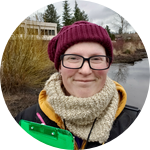About This Project
Leptospirosis is a potentially life-threatening bacterial infection of humans and other mammals which can lead to organ failure and/or meningitis. Rodents abundant in urban and rural environments are the most important reservoirs and sources of Leptospira infection. This study is an investigation of the non-native rodent, Nutria, and their association with an increase in Oregon cases.
Ask the Scientists
Join The DiscussionWhat is the context of this research?
Historic cases of Leptospirosis in Oregon have been infrequent and tied to the coast where breakouts cause sudden mortalities in sea lion and seal populations. In the last few years, however, human and animal cases in Oregon have increased dramatically. Rodents are known to be reservoirs for this bacterial parasite worldwide, often having no symptoms and passing their infection to other mammals by shedding the bacteria in their urine and contaminating water sources. For this reason, infections are associated with areas where rainfall and flooding are common. Nutria, Myocastor coypus, a large semi- aquatic rodent introduced to Oregon, have been shown to both carry and spread this bacterial parasite.
What is the significance of this project?
The WHO has estimated that there are 873,000 human cases annually worldwide. Wildlife cases are not always tracked, so the impact of this parasite is not fully understood. Identifying local reservoirs of this disease would greatly inform management practices of wildlife, veterinary vaccination protocols, and reduce the chance of misdiagnosis within human medical practices in Oregon. Although some vaccines for Leptospirosis exist for both humans and animals, administration is optional for livestock and pet owners and no public information is available for human vaccination rates in Oregon. If there is sufficient information about prevalence and risk, interest in promoting or developing more modern vaccines could change treatment worldwide.
What are the goals of the project?
The goal of this project is to investigate whether or not nutria are playing a role in the increased incidence of leptospirosis cases. our goals are: 1, estimate the proportion of nutria in western Oregon that carry the disease, 2, estimate the density of nutria in urban and disturbed wetlands, and 3, investigate methods of detecting Leptospira in water samples. The first goal is going to be completed by directly testing kidney tissue samples from nutria from multiple western Oregon counties. The second and third goals will be completed by using eDNA methods to correlate density of nutria in a waterbody to density of nutria DNA and Leptospira DNA in water samples collected from that waterbody.
Budget
Detection of Leptospirosis will be performed 2 ways in this study, first by collection of water samples from nutria infested, and no/low nutria inhabited ponds and wetlands to assess density of Nutria and presence of the parasite within that waterbody. Environmental DNA (from water samples) is notoriously difficult to detect for Leptospira species, so we will also be partnering with landowners and municipalities who regularly remove nuisance wildlife to obtain fresh kidney samples for PCR. This budget is designed with collecting 60 kidney samples and 30 eDNA samples from local waterbodies. Samples will be processed at Oregon State University.
Travel costs and hourly costs for students and volunteers are not included in this estimate. Environmental DNA test line item includes the additional equipment needed to process large volumes of water per sample.
Endorsed by
 Project Timeline
Project Timeline
Water samples of urban and disturbed wetlands could be completed as soon as this summer (2022) if funding is secured. Kidney samples can be collected from municipal nuisance control organizations and landowners in western Oregon by the end of summer 2023. DNA testing and evaluation will be done locally at OSU's Veterinary Diagnostic Laboratory as samples arrive. Analysis and reports will be finalized by Early 2024.
Jun 01, 2022
Project Launched
Aug 31, 2022
DNA tests finalized
Sep 30, 2022
Collection of water samples COMPLETED
Jun 30, 2023
Collection of kidney samples COMPLETED
Dec 22, 2023
Data Analysis
Meet the Team
Kathleen "Kacy" Woodley
Kacy is a wildlife biologist and PhD candidate at Oregon State University. She has 7+ years experience as a Biological Technician in laboratories and in the field, and 3+ years experience as a Veterinary Assistant. Her interests are Wildlife Disease Dynamics in amphibians and mammals, and Wildlife Conservation.
Additional Information
Researchers in this project are not involved in the capture or handling of any live animals. No IACUC approval is needed for research with tissue obtained in this fashion, and the appropriate Scientific Take Permit has been approved by ODFW for research with wildlife tissue samples. Tissue samples will be provided by our collaborators and processed at Oregon State University.
Additional Resources: https://www.cdc.gov/leptospiro...
Project Backers
- 8Backers
- 25%Funded
- $690Total Donations
- $48.75Average Donation

